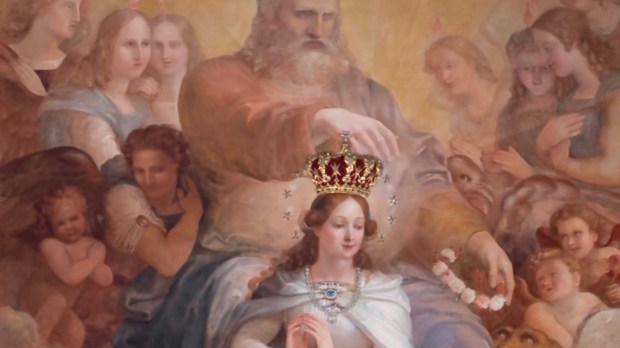Bormla (or Burmula, deriving from Bir Mula, which means [the] Well of the Lord), is an ancient city in the southeast of Malta. It is one of the cities overlooking the Malta Grand Harbor and facing the Valletta peninsula.
It forms part of “The Three Cities” locally called Bormla, Birgu and Isla, which the Hospitaller Grand Masters christened Citta’ Cospicua (Prominent city), Citta’ Vittoriosa (Victorious city) and Citta’ Invicta (Undefeated city – today known as Senglea), respectively.
Bormla and St. Paul
It is a pity that due to an unprecedented industrial development in the 19th century, and the establishment of the Royal Navy Dockyard coupled with a rushed urbanization, Bormla’s rich historical legacy and archeological remains were destroyed. The carpet bombing by the Axis on the Dockyard and the Naval Base did the rest as the city was laid to waste. The post-war reconstruction rush and lack of planning put a sad end to the Cospicuan heritage.
Yet, some heritage is vividly remembered through tradition, documents, and other sources that were not researched in previous studies. Most of its maritime heritage is less often recounted today, as the city underwent high migration during and after the War, and suffered neglect.
However, the Cospcuans, always conscious of their unique historical heritage, managed to pass on the past glories of their city from generation to generation by word of mouth. In this they copied the Hellenic bard Homer.
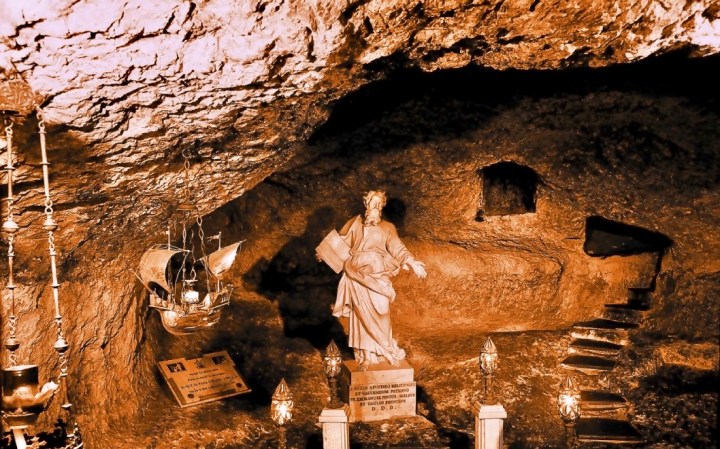
Thus not everything was lost, and tradition occupies a high place in the mindset of the citizens of Cospicua.
These traditions narrate a wonderful and exciting story of mariners and Sicilian vessels anchored in their creek; St. Paul sailing to Italy from their shores; and the Madonna beating with a branch (Marżabba) a devil who was tormenting a child cursed by her mother.
Tradition insists that St. Paul left Malta from the shores of Bormla and that a church was erected from the spot to commemorate the event. Indeed, in a study by Dr. John Vella, it transpires that recorded toponyms at Bormla, their language and maritime meaning supported by an analysis of biblical text, archaeology, architecture and pictorial sources (such as portolan charts, art, and other evidence), substantiate the veracity of the legend surviving at Bormla as a historical event. Indeed, the linguistic and naval jargon of the analyzed toponyms and its topography show that Bormla was the main harbor of Malta from antiquity to the 16th century.
… Bormla was the main harbor of Malta from antiquity to the 16th century.
The beginning of Marian devotion is lost in time
Recent studies by Prof. Fiorini and Dr. John Vella further prove the antiquity of Christian Bormla. Prof. Fiorini determined that a partially troglodytic church dedicated to the Nativity of Jesus (also known as the Church of St. Helen), goes back to the 7th century. In this church, a Latin inscription survives, and a Greek inscription that once was located around the pediment of the church has been destroyed. Dr. Vella’s study concluded that Marian devotion in Bormla started with the presence of an 8th-9th century Byzantine Nativity or Theotokos icon in this ancient church, which depicted the Holy Virgin as the bearer of God. Unfortunately, at some point this icon disappeared and was never traced.
These studies also found it evident that this church was affected by the religious developments of Christianity in the Mediterranean. It had survived the Turkish siege of 1565, but succumbed to the ravages of time, with World War II giving it its coupdegrâce. However, the troglodytic part of the church survived, namely the chancel and apse, and part of the Latin inscription, asserting the Madonna’s divine motherhood, is preserved.
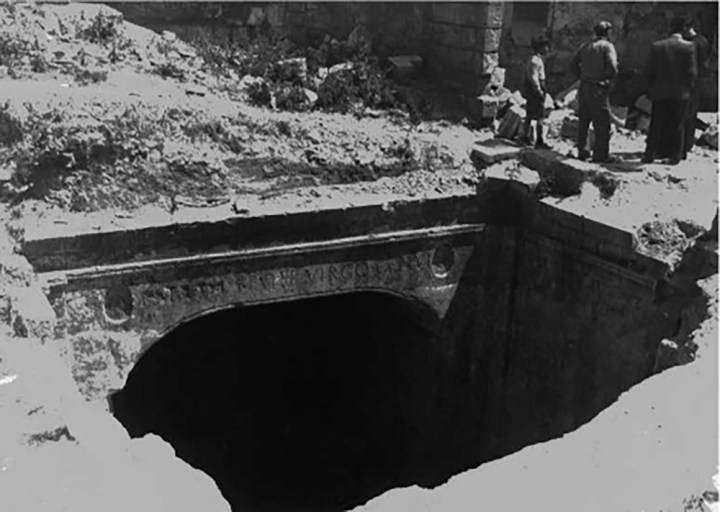
Marian devotions through time
During the 13th and 14th centuries the Auxilium Christianorum (Madonna tal-Baħrin / Our Lady of Sailors) and the Madonna tal-Marżabba (Madonna del Soccorso / Our Lady of Rescue) devotions respectively contributed to the increase of Marian devotion among the Bormla communities.
The church dedicated to the Madonna tal-Marżabba was built before the Great Siege of 1565, on the hill known as the Hill of the Gardens, where today we find the Collegiate Parish Church, as we shall see. The church enjoyed the great privilege of retaining the Blessed Sacrament in its tabernacle although it was not yet an independent parish. On December 6, 1581, a religious confraternity dedicated to Sanctae Mariae Conceptionis was founded in this church. It became a parish church in 1586, and was expanded to cater to the increase in parishioners. Its titular was Sanctae Mariae Conceptionis del Soccorso.
In 1621, its main altarpiece portrayed the Crowning of Our Lady, surrounded by various scenes from her and her Son’s lives. Above this painting there was another painting of the Blessed Virgin. As Bormla (Cospicua) grew in stature, population, trade and commerce, the church underwent structural and architectural modifications and embellishments consonant with the growing importance of the city.
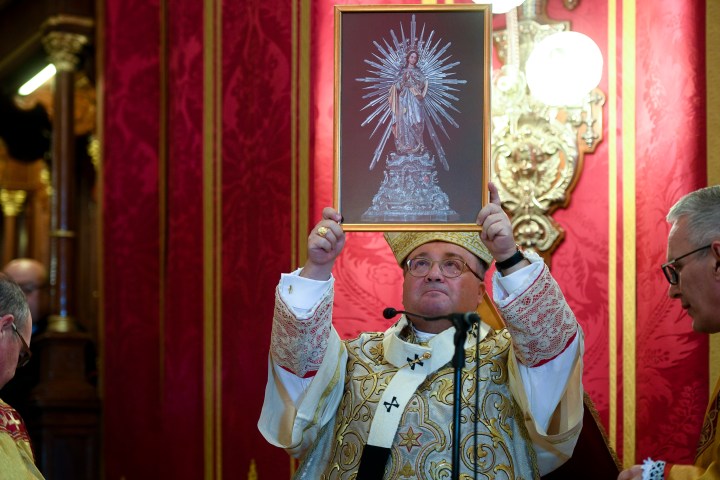
In 1684, plans to build a new church were made on the design of Vincenzo Casanova. The new church, the present Collegiate Church, was consecrated in 1732. On April 22, 1755, Bishop Paul Alpheran de Bussan approved that the church should have a Sodality of Priests, and in 1822 it was elevated to the status of a Collegiate Church. This meant that the Cospicuan priests now became canons. The church was consecrated to the Immaculate Conception (Il-Kunċizzjoni).
The glorious titular statue and altarpiece of the Immaculate Conception
The church’s original statue of Our Lady of the Immaculate Conception was sculpted in wood in around 1680 by Suor Maria de Domenici, a Carmelite tertiary and a pupil of Mattia Preti, and later on in Rome of Carlo Maratta. Tradition says that she carved the statue from the trunk of a tree on which Our Lady appeared. It is said that when Malta formed part of the Royal Domain of the Kingdom of Aragon, a Sicilian merchant sloop was anchored in the Cospicua Creek. During a dark night, a sailor heard the loud shrieks and cries of a child. He reported this to the captain and the captain himself with two other sailors landed and walked up to the Hill of Gardens, from where the cries were coming.
And behold, they saw Our Heavenly Mother on a tree, with a branch …
There, they had the fright of their lives when they saw a devil beating a hapless girl savagely; frightened to death, they fell on their knees and prayed the Blessed Virgin to help the little girl. And behold, they saw Our Heavenly Mother on a tree, with a branch (Marżabba – hence the title Madonnatal-Marżabba) in her hand, with which she beat the devil away.
As the captain approached the sobbing girl, he realized she was his daughter. Returning to his home, the captain found his wife in a desperate situation because she had cursed her daughter and prayed the devil to take her away.
The Madonna tal-Marżabba church was built near this tree as thanksgiving, and to show devotion to the Blessed Virgin Mary. On this same spot, today we find the canonical choir of the parish church.
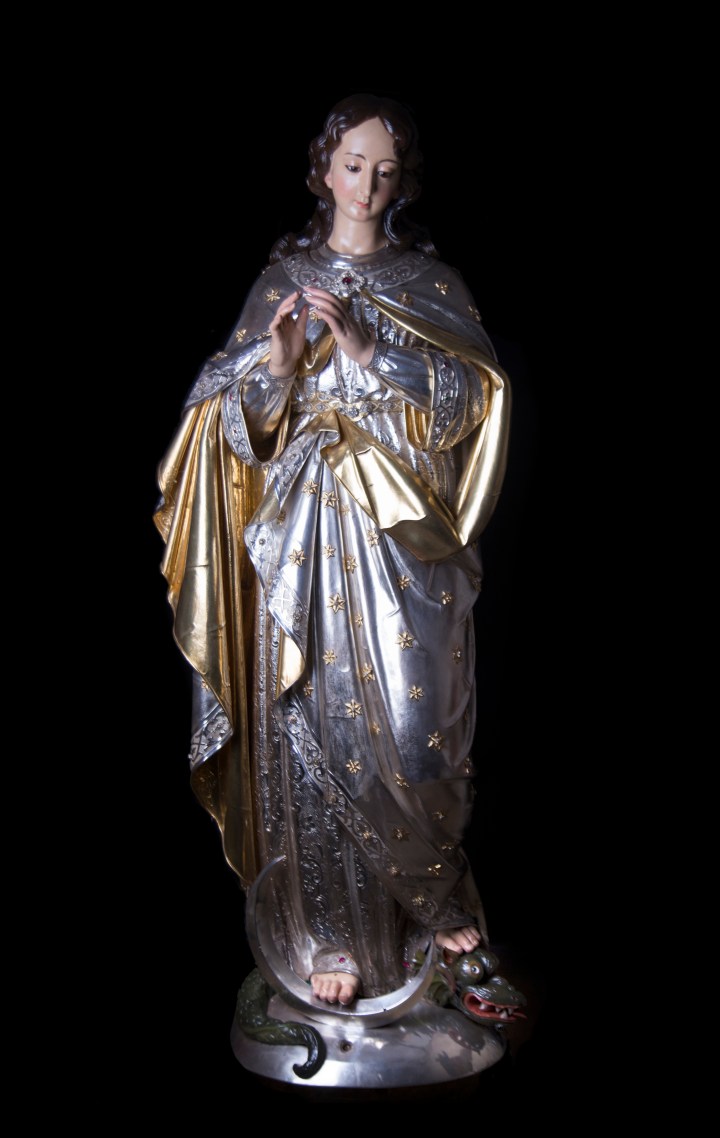
In 1905, the titular statue was sent to Milan, to the then renowned firm Antonio Ghezzi e Figli. By June 8 of that year, the beloved effigy was back in the collegiate church of Bormla, but a new body made of silver hammered sheets was created according to a design for the renovation of the statue by Abraham Gatt (1863-1944), Maltese designer, sculptor and silversmith.
The head, hands, feet and serpent were kept from the old statue and adjusted to the new design. In 2018, the team of Atelier del Restauro completed conservation and restoration works. The altarpiece painting was commissioned by Can. Fr. Ludovico Mifsud Tommasi (1796-1897) from artist Pietro Paolo Caruana (1793-1852) in 1828. Mifsud Tommasi wanted the painting to present the Immaculate Virgin dressed in white, with a blue sash around her waist – remarkably different from the iconography common at the time. (The Blessed Virgin Mary was typically depicted in red and blue garments).
Thirty years after the completion of the Altar piece, Our Lady of the Immaculate Conception appeared to St. Bernardette Soubirous in the grotto of Massabielle in Lourdes, dressed in like manner!
The altarpiece was solemnly crowned by Pope Pius X’s legate, Cardinal Ferrata, on June 25, 1905, on the occasion of the 50th anniversary of the Promulgation of the Dogma of the Immaculate Conception. In 2018, Pierre Bugeja of PrevArt finished conservation and restoration works on this painting.
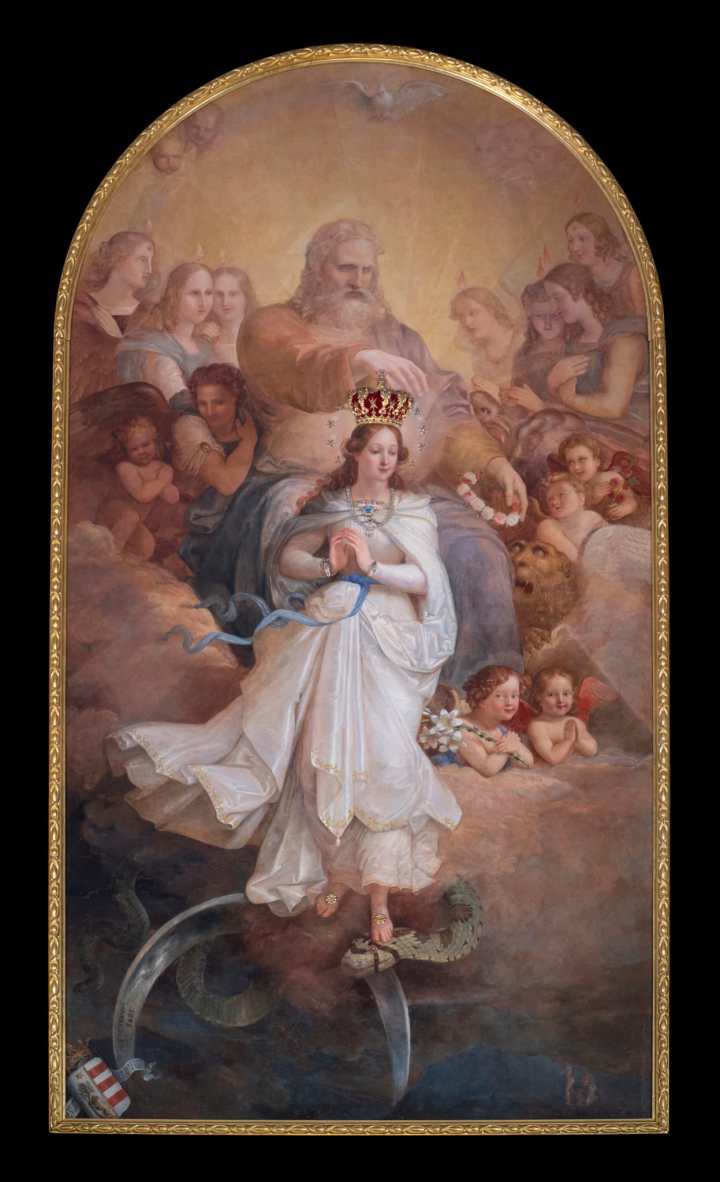
The great miracle of the Immaculate Conception
As a port and dockyard area during World War II, Bormla was one of the main targets of the enemy’s bombings. So, it was decided to transport the titular statue together with the main altarpiece and other valuable works of art to the Basilica of St. Helen in Birkirkara in order to protect them from the constant air raids on Bormla. It was declared that if the Cospicua parish church and oratory were spared from destruction, a pilgrimage would take place to bring the sacred images back. And so, it was!
The parish church was still standing after the war and torrents of bombings of the whole area! It is recorded that more than 200 bombs fell in the vicinity of the parish church, but despite the devastation all around it, the building defied the odds.
On November 19, 1944, both works of art were brought back to Cospicua followed by a sea of devotees. The pilgrimage passed through various towns and villages on its way to Cospicua.
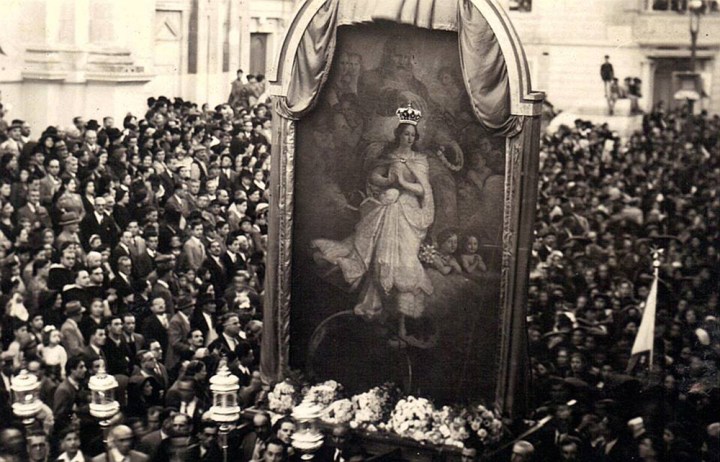
On the memorable occasion, thousands of people from towns and villages across Malta and Gozo packed the streets of the pilgrimage itinerary, celebrating the miraculous event and the end of the War. Many social clubs and band clubs, various political, religious and social representatives took part in the massive procession, today known as the National Pilgrimage of the Immaculate Conception. This happening was, and still is, considered by many to be an intervention and a miracle of the Immaculate Conception!
Check out the astonishing and heart-warming footage [preserved and digitized by Malta Audio Visual Memories], of the original 1944 pilgrimage, overflowing with devotion to the Immaculate Conception at this link. (You might have to click more than once.)
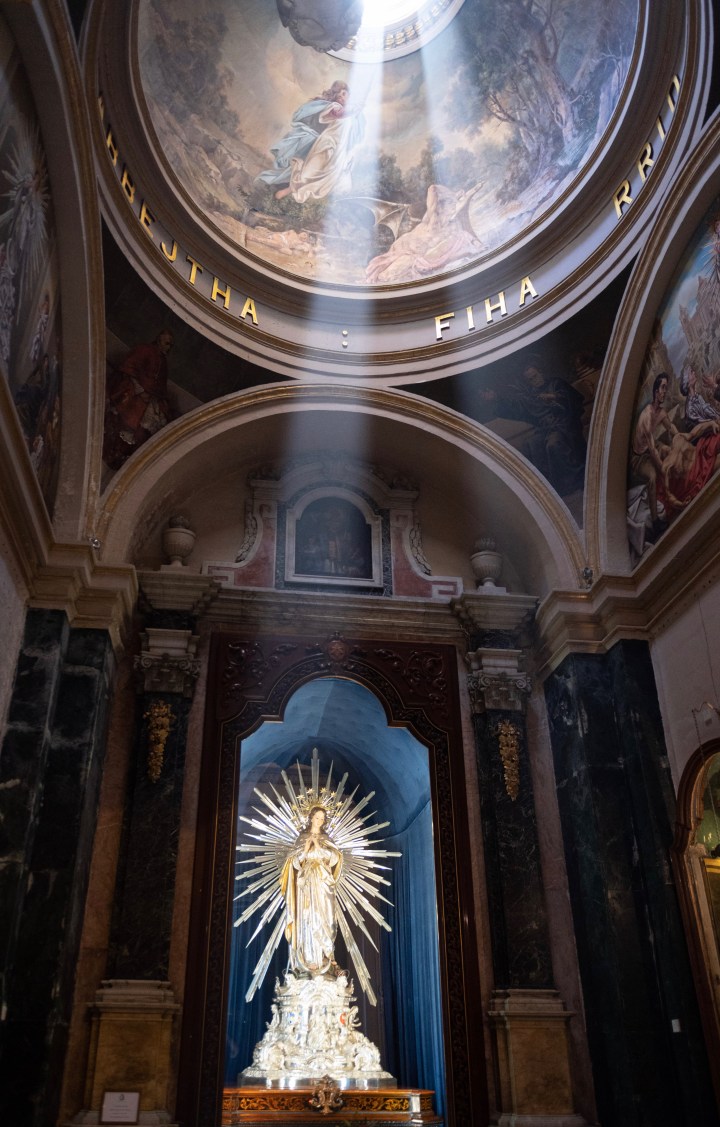
~
I would like to convey my heartfelt thanks to Canon Rev. Emmanuel Schembri from the Bormla Collegiate Parish Church and Valentina Lupo of Atelier del Restauro for their very patient support and assistance. I would also like to thank Matthew Tonna Gilford from the Cospicua parish for his invaluable help.
References
Borg V. Marian Devotions in the Islands of St. Paul. The Historical Society. Malta. 1983
Fiorini S. A Reconstruction of the Greek and Latin Inscriptions in the Church of St. Helen, Bormla. Melita Historica. Special Edition, 2020
Muscat G. Zvilipp Tal-Qima Lejn Marija Vergni Immakulata F’Bormla (Development of the Devotion to the Immaculate Virgin Mary in Bormla). Malta. 1949
Vella J. The Rock-cut Church of Bormla: Origins and Developments. Journal of Maltese History, volume 5 number 1, 2016
Vella J. Thalassic imaginaries: witnesses to (an) unwritten history. European Review of History: Revue européenne d’histoire. Published online: 07 September. 2021
Zenzani M.G., Lupo V.History, conservation and restoration of the statue of the Immaculate Conception at Cospicua. Times of Malta. 2nd December, 2018
